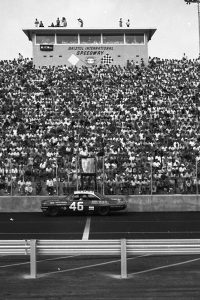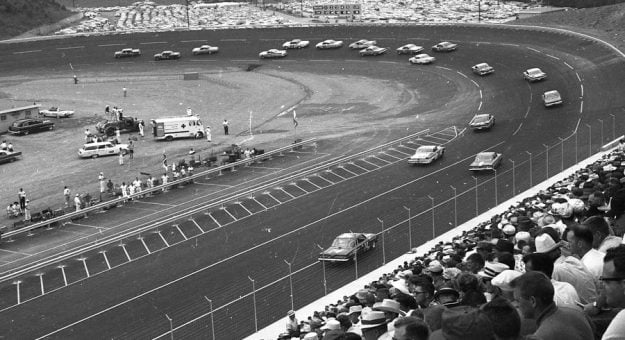The list of new venues for NASCAR’s top series was gradually growing as the 1960s commenced.
The yawning expanse of Daytona Int’l Speedway had closed out the previous decade and sweeping new ovals near Charlotte and Atlanta were quickly propelling NASCAR into the superspeedway era.
The biggest tracks, however, weren’t alone among the new venues.
In 1961, a short track also swung its gates open in the Tennessee mountains, and in its inaugural event, a journeyman stock car driver got to grab the spotlight as he never had before.
Even if another person was sharing the glare on Bristol Motor Speedway’s new stage.
Johnny Allen was the kind of guy who used to populate the ranks of the NASCAR Cup Series in great numbers. The son of a bank officer, born in 1934 in Los Angeles, Allen grew up a race fan after his father had sprinkled speedway happenings among their father-and-son outings, including midgets at Gilmore Stadium and on the dirt at Culver City.
Allen became a die-hard racing junkie at an early age and managed to wangle a stint in the seat at Southern California jalopy races, some of which involved a maturing Parnelli Jones. He drove stock cars at a facility outside Corpus Christi, Texas, while serving in the Navy.

Mustering out of the service in 1955, Allen relocated to the Southeast and commenced his run as a regular in NASCAR, driving for a series of independent owners. It didn’t take long for the transplanted Californian to show he had game.
In his most productive early season, 1957, Allen started 42 races and placed seventh in the standings.
When the big track opened in Daytona Beach, Fla., Allen finished third in the first running of the Firecracker 250. According to NASCAR historian Buz McKim, Allen joins Dick Foley and Brownie King as the only surviving drivers who raced on both the Daytona beach course and the superspeedway.
Allen’s fortunes continued to improve the following season, 1960, as he claimed second in the first Atlanta 500, backing up that strong finish by placing third in the 1961 Rebel 300 at Darlington (S.C.) Raceway.
Then came the opening of Bristol in late July, when it was a very different place than today’s concrete coliseum.
The development team of Larry Carrier, Carl Moore and R.G. Pope carved out a half-mile track in Bristol, starting construction in late 1960. About the only thing it shared with today’s Bristol was its length. Originally, the speedway was blacktopped and banked a maximum of 22 degrees.
The track did not assume its current configuration with 34-degree banks until it was rebuilt in 1969.
“I didn’t have a car back then in 1961. We’d just lost a sponsor that we had,” Allen recalled recently. “I drove a Chevrolet for Ned Jarrett, who had two cars. We’d had the same sponsor at the time, and the sponsor decided to cut down to one car, and Ned was leading the points at the time, so they went with him. Before the Bristol race, Ned called me and asked me if I had a car for the race. He offered to let me drive my old car if I could send somebody up there to get it ready.”
Driving the second 1961 Chevrolet of B.G. Holloway as a one-race teammate to Jarrett, Allen took the green flag for the 500-lap Bristol opener from 34th spot, and didn’t last, as the Chevrolet broke an axle with 106 laps in the books.
By this time, independent star Jack Smith, who could trace his NASCAR career to the very first Strictly Stock race at the Charlotte fairgrounds in 1949, took command in one of his self-owned, self-prepared Pontiacs. By the time Bristol opened, Smith owned 15 NASCAR wins, the first coming at Martinsville (Va.) Speedway in 1956 and the most recent in Greenville, S.C., two months before Bristol.
“Jack and I were good friends,” Allen said. “I had gone to work for Jack in 1959, a helper to Don Bailey, his chief mechanic, whenever he needed it. He told me I could drive his Chevrolet in some races. That was how I later became partners with Don Bailey in a couple of Chevrolets. Started last at the Daytona 500 in 1959 and finished 11th. So Jack Smith and I had gotten to know each other. He knew about my talent and that I was a conservative driver, because I had to get to the next race.”
Although few probably remember it today, Allen was an aspiring open-cockpit driver, dating back to his years as a midget fan in California, and teamed with Bailey to campaign a Chevrolet they’d bought from Roy Tyner to compete in USAC’s stock car division.
Between his NASCAR and USAC starts, Allen had hewn a solid reputation as a driver.
Allen remembers that “Big’ Bill France introduced him to Holloway, a monied enthusiast who with his wife, had made a fortune in Texas oil and international shipping. He was part of a three-car Holloway team effort that also included Jarrett and “Tiger” Tom Pistone, before they focused all their backing behind Jarrett.
At Bristol, Smith was leading the race when Allen’s Chevrolet failed.
As Allen recalls, “It was a really hot day and Bristol was already known as hard to drive. Jack Smith had a cracked exhaust, and the heat was coming up through the boot next to the gearshift, and it was getting to the point where he couldn’t keep going, so he told the crew, ‘Find a relief driver. I’m not going to be able to finish.’ And the crew said, ‘Let’s get Johnny over here, because he’ll take care of the car.’”
The exhaust heat blazing up through the floorboards seriously seared Smith’s throttle foot.
“He was leading the race when I got into the car around lap 292,” Allen said. “It was special to maintain the lead. I remember that Richard Petty was second behind Jack, and I could see him in the mirror, about a straightaway behind me, and I kept him there. Once I got used to the car because Jack’s style of driving was a little different than mine, because he liked the car to be tight, I made sure we weren’t going to blow the right-front tire. I got to the point where the car was neutral enough that I could maintain the lead. I eventually built up a two-lap lead over Fireball Roberts, who finished second.
“It was very emotional to become a winner, even though it wasn’t going to be my win,” he said.
The Bristol co-win would be the first of Allen’s career in NASCAR, but not the last.
In 1962, he switched to an independent 1961 Pontiac owned by Fred Lovette and captured his first solo NASCAR victory in the 200-lap stop at historic Bowman-Gray Stadium in Winston-Salem, N.C.
Allen edged Rex White at the line by six inches after going over the wall on the white flag lap, with a NASCAR scoring check required to determine the actual winner. Allen’s career in NASCAR subsequently settled down to single-digit start totals in the following season until 1967, when he ran his final two races.
Allen also owns a single ARCA victory and made his last start in a race car of any kind at South Carolina’s Greenville-Pickens Speedway in 1983. Today, Allen lives in Indiana, where he operated a paint store once his racing career concluded.
Allen became a special-events driver for the Ford Motor Co., driving in the Mobil Economy Run, a 40-day reliability test of Mercury Comets at Daytona in 1965 and a follow-on durability challenge the following year that saw a brace of Comets drive from the tip of South America to Fairbanks, Alaska.
“It was a good opportunity and the chance to still drive cars competitively,” Allen said. He also did a lot of test driving at Ford’s proving grounds in Michigan.
“I got to do more of that, which kind of took me out of circulation in racing. It was great to win at Bristol, and to get the opportunity in 1962 to win alone at Bowman-Gray was even better. Rex White sat on the pole, but I was on the outside pole and it was my race.”
